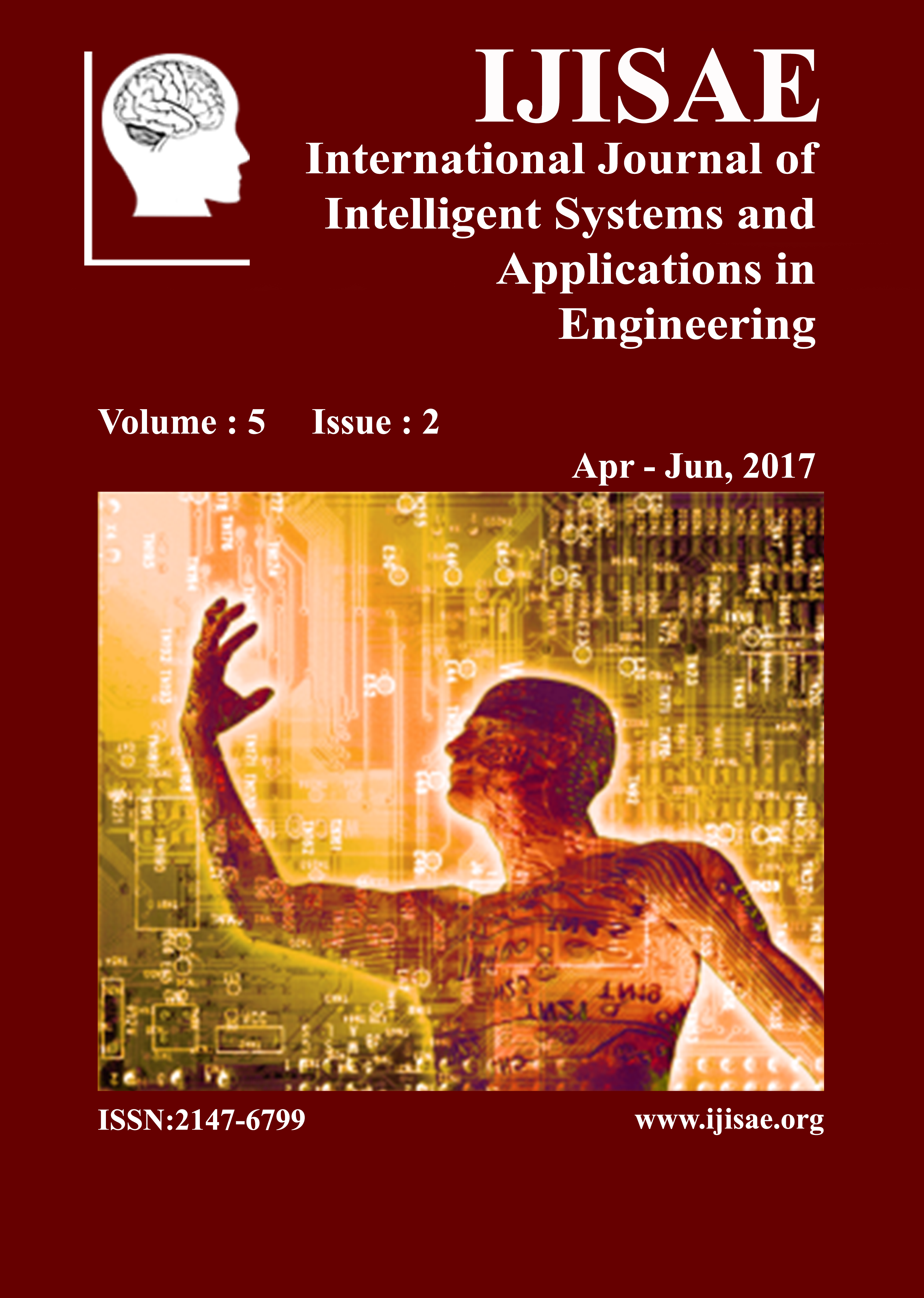Resilient Image Feature Description through Evolution
DOI:
https://doi.org/10.18201/ijisae.2017528728Keywords:
Feature Description, Matching, Genetic Algorithms, Binary Descriptors, Floating Point Descriptors, OptimizationAbstract
Feature description is an important stage in many different vision algorithms. Image features detected by various detectors can be described using descriptors either with a binary or floating-point structure. This study presents the use of evolutionary algorithms, namely Genetic Algorithms (GA), in order to improve the robustness of the feature descriptors against increasing levels of photographic distortions such as noise or JPEG compression. Original feature descriptors were evolved in order to reduce the descriptor distance for the mentioned test cases. Results, tested using a statistical framework, suggest that the evolved descriptors offer better matching performance for two state-of-the-art descriptors.
Downloads
References
M. Zuliani, C. Kenney, and B. S. Manjunath, “A mathematical comparison of point detectors," in IEEE Computer Vision and Pattern Recognition, 2004.
M. Shneier, “Extracting linear features from images using pyramids," Systems, Man, and Cybernetics, IEEE Transactions, vol. 12, pp. 569-572, 1982.
G. R. Cross and A. K. Jain, “Markov random field texture models," Pattern Analysis and Machine Intelligence, no. 1, pp. 25-39, 1983.
J. Shi and J. Malik, “Normalized cuts and image segmentation," in Computer Vision and Pattern Recognition, 1997. Proceedings., 1997 IEEE Computer Society Conference on, pp. 731-737, 1997.
N. Dalal and B. Triggs, “Histograms of oriented gradients for human detection”, in Computer Vision and Pattern Recognition, 2005. CVPR 2005., vol. 1, pp. 886-893, 2005.
T. Tuytelaars and K. Mikolajczyk, “Local invariant feature detectors:A survey”, Foundations and Trends in Computer Graphics and Vision, vol. 3, no. 3, pp. 177-280, 2008.
E. Bostanci, N. Kanwal, and A. Clark, “Spatial statistics of image features for performance comparison," Image Processing, IEEE Transactions, vol. 23, pp. 153-162, 2014.
N. Kanwal, E. Bostanci, and A. Clark, ”Evaluation method, dataset size or dataset content: How to evaluate algorithms for image matching?," Journal of Mathematical Imaging and Vision, 2016.
C. Schmid, R. Mohr, and C. Bauckhage, “Evaluation of interest point detectors," International Journal of Computer Vision, pp. 151-172, 2000.
O. M. Mozos, A. Gil, M. Ballesta, and O. Reinoso, “Interest point detectors for visual slam," Current Topics in Artificial Intelligence, vol. 4788, pp. 170-179, 2007.
S. Smith and J. Brady, “Susan: A new approach to low level image processing," International Journal of Computer Vision, vol. 23, no. 1, pp. 45-78, 1997.
E. Cohen and Y. Yitzhaky, “Blind image quality assessment considering blur, noise, and jpeg compression distortions," in Optical Engineering+Applications, International Society for Optics and Photonics, 2007.
A. E. Eiben and J. E. Smith, Introduction to Evolutionary Computing SpringerVerlag, 2003.
S. Cagnoni, E. Lutton, and G. Olague, Genetic and evolutionary computation for image processing and analysis. Hindawi Publishing Corporation, 2007.
L. Chen, B. Chen, and Y. Chen, “Image feature selection based on ant colony optimization," in AI 2011: Advances in Artificial Intelligence, vol. 7106 of LNCS, pp. 580-589, Springer, 2011.
D. Ozkan, “Feature selection for face recognition using a genetic algorithm”, Department of Computer Engineering, Bilkent University, 2006.
E. Bostanci, “Enhanced image feature coverage: Key-point selection using genetic algorithms," arXiv preprint arXiv:1512.03155, 2015.
M. Calonder, V. Lepetit, C. Strecha, and P. Fua, “Brief: Binary robust independent elementary features," Computer Vision,ECCV 2010, pp. 778-792, 2010.
E. Rublee, V. Rabaud, K. Konolige, and G. Bradski, “Orb: an efficient alternative to sift or surf," in Computer Vision (ICCV), pp. 2564-2571, IEEE, 2011.
S. Leutenegger, M. Chli, and R. Y. Siegwart, “Brisk: Binary robust invariant scalable keypoints," in ICCV, pp. 2548-2555, IEEE, 2011.
A. Alahi, R. Ortiz, and P. Vandergheynst, “Freak: Fast retina keypoint," in Computer Vision and Pattern Recognition (CVPR), pp. 510-517, IEEE, 2012.
G. Levi and T. Hassner, “Latch: Learned arrangements of three patch codes," arXiv preprint arXiv:1501.03719, 2015.
D. G. Lowe, “Distinctive image features from scale-invariant keypoints,"Int. J. Comput. Vision, vol. 60, no. 2, pp. 91{110, 2004.
H. Bay, T. Tuytelaars, and L. Van Gool, “Surf: Speeded up robust features," in Computer vision, ECCV 2006, pp. 404-417, Springer, 2006.
P. F. Alcantarilla, A. Bartoli, and A. J. Davison, “Kaze features," ECCV 2012, pp. 214-227, Springer, 2012.
P. F. Alcantarilla and T. Solutions, “Fast explicit diffusion for accelerate features in nonlinear scale spaces," IEEE Trans. Patt. Anal. Mach. Intell, vol. 34, no. 7, pp. 1281-1298, 2011.
B. Bostanci and E. Bostanci, “An evaluation of classification algorithms using Mc Nemar's test," in Proceedings of Seventh International Conference on Bio-Inspired Computing: Theories and Applications, vol., pp. 15-26, 2013.
E. Bostanci, “Is hamming distance only way for matching binary image feature descriptors?,” IET Electronics Letters, vol. 50, pp. 806-808, May, 2014.
Z. Michalewicz, Genetic Algorithms + Data Structures = Evolution Programs. Artificial intelligence, Springer, 1996.
M. Fagerland, S. Lydersen, and P. Laake, “The Mc Nemar test for binary matched-pairs data: mid-p and asymptotic are better than exact conditional," BMC Medical Research Methodology, vol. 13, no. 1, 2013.
Downloads
Published
How to Cite
Issue
Section
License
Copyright (c) 2017 International Journal of Intelligent Systems and Applications in Engineering

This work is licensed under a Creative Commons Attribution-ShareAlike 4.0 International License.
All papers should be submitted electronically. All submitted manuscripts must be original work that is not under submission at another journal or under consideration for publication in another form, such as a monograph or chapter of a book. Authors of submitted papers are obligated not to submit their paper for publication elsewhere until an editorial decision is rendered on their submission. Further, authors of accepted papers are prohibited from publishing the results in other publications that appear before the paper is published in the Journal unless they receive approval for doing so from the Editor-In-Chief.
IJISAE open access articles are licensed under a Creative Commons Attribution-ShareAlike 4.0 International License. This license lets the audience to give appropriate credit, provide a link to the license, and indicate if changes were made and if they remix, transform, or build upon the material, they must distribute contributions under the same license as the original.










